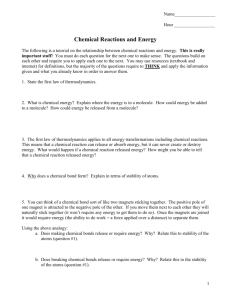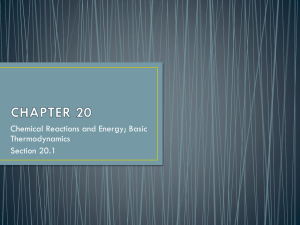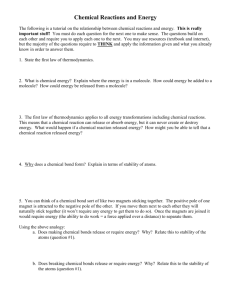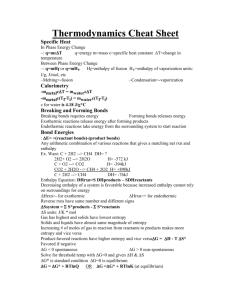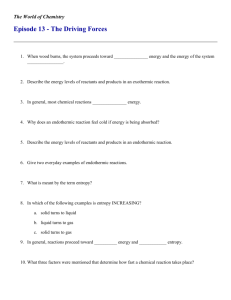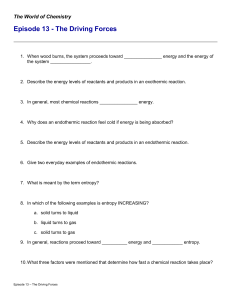Chemical Reactions and Energy KEY
advertisement
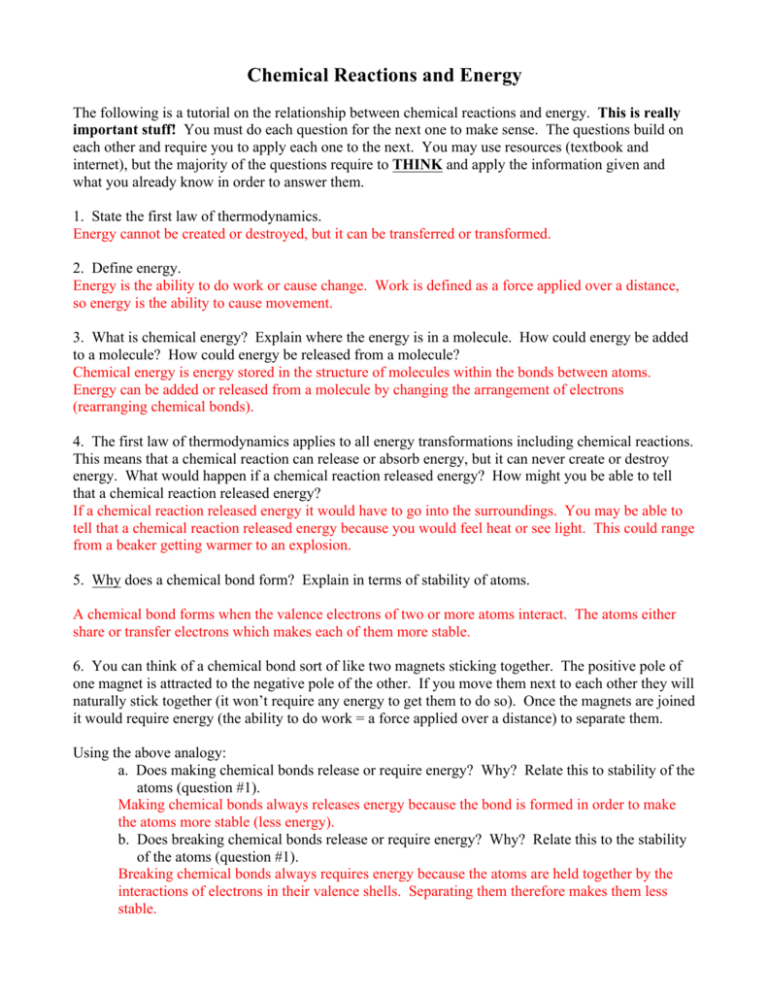
Chemical Reactions and Energy The following is a tutorial on the relationship between chemical reactions and energy. This is really important stuff! You must do each question for the next one to make sense. The questions build on each other and require you to apply each one to the next. You may use resources (textbook and internet), but the majority of the questions require to THINK and apply the information given and what you already know in order to answer them. 1. State the first law of thermodynamics. Energy cannot be created or destroyed, but it can be transferred or transformed. 2. Define energy. Energy is the ability to do work or cause change. Work is defined as a force applied over a distance, so energy is the ability to cause movement. 3. What is chemical energy? Explain where the energy is in a molecule. How could energy be added to a molecule? How could energy be released from a molecule? Chemical energy is energy stored in the structure of molecules within the bonds between atoms. Energy can be added or released from a molecule by changing the arrangement of electrons (rearranging chemical bonds). 4. The first law of thermodynamics applies to all energy transformations including chemical reactions. This means that a chemical reaction can release or absorb energy, but it can never create or destroy energy. What would happen if a chemical reaction released energy? How might you be able to tell that a chemical reaction released energy? If a chemical reaction released energy it would have to go into the surroundings. You may be able to tell that a chemical reaction released energy because you would feel heat or see light. This could range from a beaker getting warmer to an explosion. 5. Why does a chemical bond form? Explain in terms of stability of atoms. A chemical bond forms when the valence electrons of two or more atoms interact. The atoms either share or transfer electrons which makes each of them more stable. 6. You can think of a chemical bond sort of like two magnets sticking together. The positive pole of one magnet is attracted to the negative pole of the other. If you move them next to each other they will naturally stick together (it won’t require any energy to get them to do so). Once the magnets are joined it would require energy (the ability to do work = a force applied over a distance) to separate them. Using the above analogy: a. Does making chemical bonds release or require energy? Why? Relate this to stability of the atoms (question #1). Making chemical bonds always releases energy because the bond is formed in order to make the atoms more stable (less energy). b. Does breaking chemical bonds release or require energy? Why? Relate this to the stability of the atoms (question #1). Breaking chemical bonds always requires energy because the atoms are held together by the interactions of electrons in their valence shells. Separating them therefore makes them less stable. 7. A chemical reaction always involves both breaking bonds (of the reactants) and making bonds (of the products). Therefore a chemical reaction may absorb energy overall or release energy overall (compare how much energy is required to break reactants to how much energy is released when products form). Endo = within Exo = outside therm = heat Write a definition for the following types of reactions: a. Endothermic Heat energy is absorbed from the surroundings. The energy level of the products is higher than the energy level of the reactants. b. Exothermic Heat energy is released to the surroundings. The energy level of the products is lower than the energy level of the reactants. 8. Which type of reaction would involve stronger (more stable) bonds in the products than in the reactants? Which would involve stronger (more stable) bonds in the reactants than in the products? An exothermic reaction would results in products with more stable bonds (lower energy). An endothermic reaction would result in products with a higher energy (less stable). 9. The following are energy diagrams for endothermic and exothermic reactions. Next to each diagram write out in words what the graph is telling you. Endothermic Exothermic Energy is absorbed overall – energy level of products is higher than reactants ↑ Energy Reaction time Energy is released overall – energy level of products is lower than reactants ↑ Energy Reaction time 10. Energy is a driving force of chemical reactions. Look at the diagrams above. Which type of reaction do you think tends to occur on its own (spontaneous) and which type tends to not occur on its own? Explain your answer. Hint: think of the graph like a hill and the chemical reaction as a ball that rolls up or down the hill. Exothermic reactions tend to be spontaneous because they release energy overall (the “ball” is rolling down the hill which releases energy). Both reactions have a small bump to overcome called the activation energy (the energy needed to get molecules moving fast enough to bump into each other and react). 11. The second driving force of chemical reactions is entropy. Define entropy. Entropy is a measure of the disorder of a system. 12. State the second law of thermodynamics. Energy transfers and transformations increase the entropy of the universe (entropy is always increasing.) 13. Explain how each of the following is an example of increasing entropy: a. Liquid water being heated until it all evaporates as a gas As a liquid becomes a gas the molecules separate from each other and become less organized b. Sugar being broken down in cells to release energy to do work (cellular respiration). Hint: The overall chemical equation for this is C6H12O6 + 6O2 → 6CO2 + 6H2O Glucose is a highly organized molecule and is broken down into smaller more stable molecules c. A log being burned A log is an organized collection of molecules. As it is burned it becomes ash and gases in the air, which are much less organized. 14. Give two examples of chemical reactions or processes that living organisms undergo that decreases the entropy of their cells or bodies. Growing, building a muscle or bone, making new cells, repairing cells or organs, concentrating substances in one part of the cell 15. The natural direction of change is always toward more entropy. How is it then that organisms are able to become more organized? Are they defying the laws of the universe? Explain your answer. Organisms use energy to overcome the entropy and organize themselves, but they are not defying the laws of thermodynamics because as they become more organized the entropy of their surroundings increases (mainly heat). Now let’s put it all together… Gibbs Free Energy 16. Free energy is the energy of a system that is available to do work. Gibbs free energy (ΔG) is a measure of the useful energy of a system. Gibbs free energy takes into account the enthalpy (heat) change in a reaction as well as the change in entropy. The change in enthalpy and entropy are calculated by taking the values of the products – the values of the reactants. Gibbs Free Energy ΔG = ΔH – T ΔS ΔG = change in Gibbs free energy ΔS = change in entropy ΔH = change in enthalpy (heat) ΔT = absolute temperature (in Kelvin) The change in enthalpy or entropy is calculated by subtracting the value of the reactants from the products. For example, ΔH = (enthalpy of products) – (enthalpy of reactants). If ΔH < 0 would the reaction be endothermic or exothermic? Explain. A negative change in enthalpy would be an exothermic reaction because the products contain less energy than the reactants. What type of ΔS value would represent ice melting (positive, negative, or zero)? Explain. ΔS would be greater than zero because the molecules are becoming more disorganized as ice melts. 17. Determine whether each of the following reactions will be spontaneous or nonspontaneous: ΔG < 0 spontaneous (loss of free energy) ΔG = 0 nonspontaneous (in equilibrium) ΔG > 0 nonspontaneous (absorbs free energy from surroundings) 18. If ΔG > 0 the reaction is endergonic. If ΔG < 0 the reaction is exergonic. Define the terms endergonic and exergonic in your own words in terms of free energy and spontaneity. Endergonic reactions store free energy and are not spontaneous. Exergonic reactions release free energy and are spontaneous. 19. Under what conditions could an endothermic reaction be spontaneous. Explain your answer. (Hint: what other term is included in Gibbs free energy and what would that value have to be in order to offset a positive enthalpy change?). An endothermic reaction could be spontaneous if it involved a large increase in entropy. In an endothermic reaction ΔH > 0, but ΔG could still be less than zero if ΔS was large and positive. 20. How could a spontaneous reaction be used to drive a nonspontaneous reaction? This coupling of reactions is very important in biological systems! Use the diagram to help you think about it. A spontaneous reaction releases free energy that could be harnessed to power a nonspontaneous reaction. For example if the block in the picture pushed a wheel as it slid down the hill that energy could be used to push another block up the hill. Created by Wendy Johnson John3062@msu.edu
